 |
Search the Site with

|
USS Antietam (CV 36)
- later CVA 36, later CVS 36 -- decommissioned -
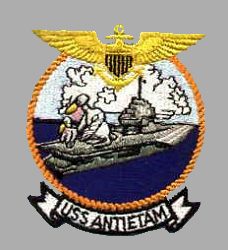 | 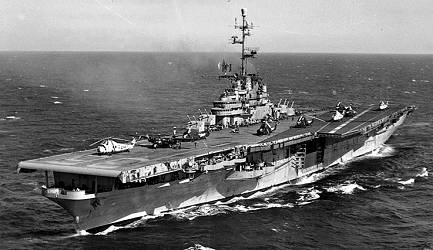 |
USS ANTIETAM was one of the ESSEX - class aircraft carriers and the second ship in the Navy to bear the name. Commissioned as CV 36, her designation was changed to CVA 36 in October 1952, and to CVS 36 in August 1953. In December 1952, the ANTIETAM became the first carrier in the Navy to be equipped with an angled-deck. Decommissioned on May 8, 1963, and stricken from the Navy list on May 1, 1973, the ANTIETAM was sold for scrapping in early 1974.
| General Characteristics: | Awarded: 1942 |
| Keel laid: March 15, 1943 | |
| Launched: August 20, 1944 | |
| Commissioned: January 28, 1945 | |
| Decommissioned: May 8, 1963 | |
| Builder: Philadelphia Naval Shipyard, Philadelphia, Penn. | |
| Propulsion system: 8 boilers | |
| Propellers: four | |
| Aircraft elevators: three | |
| Arresting gear cables: four | |
| Catapults: two | |
| Length: 888.5 feet (270.8 meters) | |
| Flight Deck Width: 153.9 feet (46.9 meters) | |
| Beam: 92.85 feet (28.3 meters) | |
| Draft: 30.8 feet (9.4 meters) | |
| Displacement: approx. 38,000 tons full load | |
| Speed: 33 knots | |
| Planes: 80 planes | |
| Crew: approx. 3460 | |
| Armament: see down below |
Crew List:
This section contains the names of sailors who served aboard USS ANTIETAM. It is no official listing but contains the names of sailors who submitted their information.
- Click here to view the list.
- Click here
to see which USS ANTIETAM memorabilia are currently for sale on ebay.
USS ANTIETAM Cruise Books:
- Crossing the Line Booklet 1947
- Atlantic Cruise Book 1952-53
- Mediterranean Cruise Book 1955
- Mediterranean Cruise Book 1956
About the different armament:
- 1945: 12 5-inch (12.7 cm) 38 caliber guns, 44 40mm guns and 39 20mm guns
- 1953: 10 5-inch (12.7 cm) 38 caliber guns and 32 40mm guns
- 1960: 8 5-inch (12.7 cm) 38 caliber guns
Accidents aboard USS ANTIETAM:
| Date | Where | Events |
|---|---|---|
| November 20, 1946 | Hunters Point Naval Shipyard, San Francisco, Calif. | USS ANTIETAM suffers an explosion at the Hunters Point Naval Shipyard, killing one and injuring 34. |
| October 30, 1951 | off Korea | A F4U aircraft assigned to VC-3 crashes over the port side during a night landing. The pilot, LTJG R. E. Kramer is recovered by the USS EVERSOLE (DD 789) with no injuries. |
| November 4, 1951 | off Korea | During the launch of a VC-35 AD-4NL aircraft, a bridle breaks on the port catapult causing the plane to crash into the water. All three crew of the aircraft are rescued successfully by the USS UHLMANN (DD 687). |
| November 4, 1951 | off Korea | Approx. three hours after the accident mentioned above, a VF-837 F9F aircraft is approaching the ANTIETAM. The pilot, LT George S. Braikard, is making a hard landing causing his plane to bounce without catching a wire. The pilot now pushes over to get the plane down, landing nosewheel first. The nose tire immediately blows and the aircraft slides over the deck crashing into the parked planes forward. The pilot and a deck crewman are killed instantly while two other crewmembers die later that day from their injuries. Ten other crewmembers are injured and seven parked aircraft are damaged. |
| November 12, 1951 | off Korea | A F4U aircraft assigned to VC-3 crashes after a normal catapult shot from the port catapult. The pilot is rescued unharmed by the USS BOYD (DD 754). |
| December 6, 1951 | off Korea | An aircraft crashes shortly after take-off from the USS ANTIETAM. The pilot is rescued by the ship's helicopter. |
| January 17, 1952 | off Korea | A F9F aircraft crashes shortly after take-off from the USS ANTIETAM. The pilot is slightly injured and is rescued by the ship's helicopter. |
| January 21, 1952 | off Korea | AN Edward J. C. Farrell, assigned to VF-837, is working on the flight deck when he gets disoriented during a snow squall and falls overboard. A 3 1/2 hour search involving three destroyers had negative results. |
| January 29, 1952 | off Korea | A F9F-2P aircraft assigned to VC-61 and piloted by LT Stan Kalas, hits the ramp while approaching the ANTIETAM. The plane slides over the deck and crashes into the water. The pilot is recovered the minor injuries by a rescue helicopter. |
| February 29, 1952 | off Korea | A F9F aircraft accidentally fires one 20mm round after landing hitting a deck crewman in the abdomen. The sailor is critically injured. Later in the day, he's transfered to a destroyer for transportation to a hospital ship. |
| October 22, 1956 | off Brest, France | USS ANTIETAM is grounded on a sandbank for six hours off Brest, France, until pulled free by tugs. ANTIETAM suffers no damage. |
| May 20, 1957 | New Orleans, La. | USS ANTIETAM crashes into a river wharf in New Orleans, La. The wharf is heavily damaged, while damage to the ANTIETAM is light. |
About the Ship's Name:
The ship was named ANTIETAM to commemorates a site along Antietam Creek, near Sharpsburg, Maryland, at which a major Civil War battle was fought.
The Battle of Antietam, on 17 September 1862, climaxed the first of Confederate General Robert E. Lee's two attempts to carry the war from the South into the North. Some 41,000 Southerners were pitted against the 87,000-man Federal Army of the Potomac under General George B. McClellan.
After his great victory at Manassas in August, Lee had marched his Army of Northern Virginia into western Maryland, hoping to find vitally needed men and supplies. McClellan moved his army westward to cut off Lee and protect Washington and Baltimore from being separated. McClellan followed Lee, first to Frederick, where through rare good fortune, a copy of Lee's battle plan fell into his hands, then westward twelve miles to the passes of South Mountain. There, on 14 September, Lee tried to block the Union troops. McClellan forced his way through the out-manned Southern ranks. Over the next two days, new battle lines were drawn west and east of Antietam Creek. The battle opened at dawn on the 17th and moved to three different locations throughout the day.
More Americans were killed or wounded in the Battle of Antietam than on any other single day in American history. Federal losses were 12,410 and Confederate losses were 10,700. Although neither side gained a decisive victory, Lee's failure to carry the war effort effectively into the North caused Great Britain to postpone recognition of the Confederate government. The battle also gave President Abraham Lincoln the opportunity to issue the Emancipation Proclamation.
History of USS ANTIETAM:
USS ANTIETAM was laid down on 15 March 1943 by the Philadelphia Navy Yard; launched on 20 August 1944 sponsored by Mrs. Millard E. Tydings, the wife of Senator Tydings of Maryland; and commissioned on 28 January 1945, Capt. James R. Tague in command.
The aircraft carrier completed fitting out at Philadelphia until 2 March 1945 when she got underway for her shakedown cruise. The ship arrived in Hampton Roads on the 5th and conducted operations from Norfolk until 22 March when she stood out of Chesapeake Bay bound for Trinidad in the British West Indies. At the conclusion of her shakedown cruise, ANTIETAM returned to Philadelphia on 28 April to begin post-shakedown availability. She completed repairs on 19 May and departed Philadelphia that same day.
After a three-day stop at Norfolk, the warship resumed her voyage to the Panama Canal in company with USS HIGBEE (DD 806), USS GEORGE W. INGRAM (APD 43), and USS IRA JEFFERY (APD 44). She arrived at Cristobal on 31 May 1945, transited the canal the next day, and continued her voyage up the coast to San Diego. She stopped at San Diego from 10 to 13 June before beginning the first leg of her transpacific voyage. ANTIETAM arrived in Pearl Harbor on the 19th and remained in the Hawaiian Islands conducting training missions until 12 August. On that day, she shaped a course for the western Pacific.
Three days out of Oahu, she received word of the Japanese capitulation and the consequent cessation of hostilities. Thus, by the time of her arrival in Eniwetok Atoll on 19 August 1945, her mission changed from combat to occupation support duty. On the 21st she exited the lagoon in company with USS CABOT (CVL 28) and a screen of destroyers bound for Japan. En route, she suffered some internal damage which forced her into port at Apra Harbor Guam, for inspections. The inspection party deemed the damage minimal; and the carrier remained operational, resuming her course on the 27th. By that time, however, her destination had been changed to the coast of the Asian mainland. She stopped at Okinawa between 30 August and 1 September and arrived in Chinese waters near Shanghai the following day.
The aircraft carrier remained in the Far East for a little more than three years. The Yellow Sea constituted her primary theater of operations while her air group provided support for the Allied occupation of North China, Manchuria, and Korea. During the latter stages of that assignment, her airmen conducted surveillance missions in that area as a result of the civil war in China between communist and nationalist factions which later resulted in the expulsion of Chiang Kai-shek's forces from mainland China and the establishment of Mao Tse-Tung's communist People's Republic of China. Throughout the period, however, she did depart the Yellow Sea on occasion for visits to Japan, the Philippines, Okinawa, and the Marianas. Early in 1949, she concluded her mission in the Orient and headed back to the United States for deactivation.
ANTIETAM remained in reserve at Alameda, Calif., until communist forces from the north invaded South Korea in the summer of 1950. She began reactivation preparations on 6 December and went back into commission on 17 January 1951, Capt. George J. Dufek in command.
Initially, the carrier conducted shakedown training and carrier qualifications along the California coast, first out of Alameda and, after 14 May 1951, out of San Diego. She made one voyage to Pearl Harbor and back to San Diego in July and August before departing the latter port on 8 September and heading for the Far East. ANTIETAM arrived in the Far East later that fall and, by late November, began the only combat deployment of her career. During that tour, she made four cruises with Task Force (TF) 77, in the combat zone off the coast of Korea.
In between fighting assignments, she returned to Yokosuka, Japan. During each of those periods, her air group carried out a variety of missions in support of United Nations forces combating North Korean aggression. Those missions included combat air patrol logistics interdiction - particularly against railroad and highway traffic - reconnaissance antisubmarine patrols, and night heckler missions. Between late November 1951 and mid-March 1952, ANTIETAM's air group flew nearly 6,000 sorties of all types. She returned to Yokosuka on 21 March 1952 at the conclusion of her fourth cruise with TF 77 to begin preparations for her voyage back to the United States.
The aircraft carrier returned home in April and rejoined the Pacific Reserve Fleet briefly. She was reactivated later that summer and, in August, transited the Panama Canal to join the Atlantic Fleet. In September, the warship entered the New York Naval Shipyard for major alterations. In October, she was redesignated an attack aircraft carrier, CVA 36. In December 1952, ANTIETAM emerged from the yard as America's first angled-deck aircraft carrier.
She operated out of Quonset Point, R.I., until the beginning of 1955. During the intervening years, she participated in numerous fleet and independent ship's exercises. After August 1953, at which time she was redesignated an antisubmarine warfare (ASW) carrier, CVS 36, ANTIETAM concentrated up on honing her hunter/killer skills. In January 1955, she embarked upon a voyage to the Mediterranean Sea where she served with the 6th Fleet until March. Resuming duty with the Atlantic Fleet ASW forces, she operated along the eastern seaboard until the fall of 1956. In October of that year, she cruised to the waters of the eastern Atlantic for NATO ASW exercises and goodwill visits to ports in Allied countries.
While the carrier was in Rotterdam, the Suez crisis broke out in the eastern Mediterranean. ANTIETAM cut short her visit to the Netherlands and headed for the "middle sea" to bolster the 6th Fleet during the evacuation of American citizens from Alexandria, Egypt. At the end of that assignment, she conducted ASW training exercises with Italian naval officers embarked before returning to Quonset Point on 22 December 1956.
After resuming operations along the eastern seaboard early in 1957, ANTIETAM was assigned on 21 April 1957 to training duty with the Naval Air Training Station, Pensacola, Fla. Mayport, however, served as her home port because ships of her draft could not then enter port at Pensacola. For almost two years the aircraft carrier operated out of Mayport training new Navy pilots and conducting tests on new aviation equipment-most noteworthy on the Bell automatic landing system during August of 1957. She also participated in annual Naval Academy midshipmen cruises each summer.
In January 1959, after the deepening of the channel into Pensacola had been completed, ANTIETAM's home port was changed from Mayport to Pensacola. For the remainder of her active career, the carrier operated out of Pensacola as an aviation training ship. On two occasions, she provided humanitarian services to victims of hurricane damage. The first came in September of 1961 when she rushed to the Texas coast to provide supplies and medical assistance to the victims of hurricane Carla. The second came just over a month later when she carried medical supplies, doctors, nurses, and other medical personnel to British Honduras to help with the victims of hurricane Hattie. Otherwise, she spent the final four years of her naval career in routine naval aviation training duty out of Pensacola.
On 23 October 1962, ANTIETAM was relieved by USS LEXINGTON (CVS 16) as aviation training ship at Pensacola and was placed in commission, in reserve, on 7 January 1963. Berthed at Philadelphia, Pa., she remained in reserve until May of 1973 when her name was struck from the Navy list. On 28 February 1974, she was sold to the Union Minerals & Alloys Corp. for scrapping.
ANTIETAM earned two battle stars for service in the Korean conflict.
USS ANTIETAM Image Gallery:
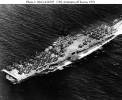 | 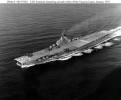 | 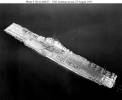 | 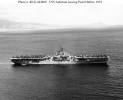 | 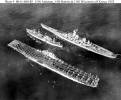 |
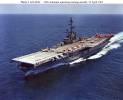 | 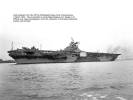 | 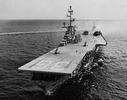 |
 Back to Carriers list.
Back to Carriers list.